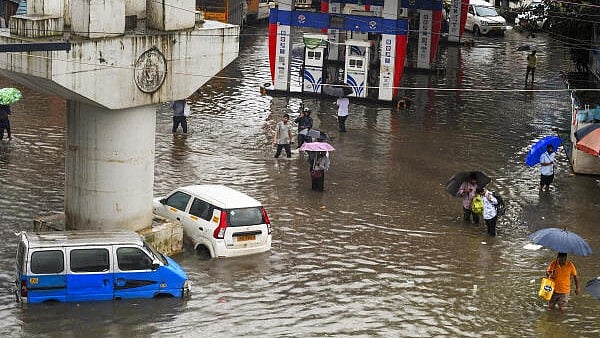
Commuters wade through a waterlogged road amid rainfall in Mumbai.
Credit: PTI Photo
New Delhi: Excess rainfall in Mumbai claims over 2,300 lives every monsoon season through a cascade of direct and indirect effects, scientists reported on Wednesday, noting that excess mortality periods continue for at least five weeks after each episode of intense rain.
Heavy downpour and flooding in the coastal mega city could be responsible for approximately 8 per cent of the city’s total deaths in the four monsoon months, they said, flagging that the most affected are children under five years and slum dwellers.
Their study – published in Nature – is possibly the first one on the health impacts of rainfall and flooding in big Indian cities.
They found that rainfall contributed to around 8 per cent of deaths during monsoon, which is equated to 2,308-2,718 excess lives lost per year.
These figures are comparable to Mumbai’s deaths from all cancers over the same time periods, reported the team comprising Tom Bearpark at Princeton University, Ashwin Rode at the University of Chicago and Archana Patankar, Green Globe Consulting, Mumbai.
The researchers used ten years (2006-2015) of rain records maintained by Municipal Corporation of Greater Mumbai and matched excess rainfall (like over 150 mm) days with mortality records that come with addresses, on the basis of which they identified if an individual lives in a slum.
“Our estimates are substantially higher than those recorded in official statistics. Our results highlight a major, under-studied public-health impact of rainfall in one of the world’s largest cities, and suggest that climate change and sea-level rise could worsen these risks in the absence of significant adaptations,” Bearpark told DH.
“Further, we find that these impacts are highly unequal, with slum residents, children, and women most affected.”
A day with 150 mm rainfall causes a 2.2 per cent increase in the general mortality rate in India’s financial capital across the subsequent five weeks, probably due to a combination of factors including drowning, electrocution, spread of diseases like diarrhoea, dengue, malaria and typhoid, and people’s inability to seek timely hospital care.
The relative risk of increased mortality rates over the five weeks after a 150-mm rainfall event was highest in children under five years (5.3 per cent) relative to older individuals, and higher in women.
More than 80 per cent of the deaths associated with extreme rainfall occurred in people living in informal slum settlements.
The study didn’t look at the cause of mortality, but researchers said that diseases like diarrhoea and dengue that may take days or weeks to spread may play a role.
“The extended duration of the mortality impacts suggests diseases that take days or weeks to spread play a key role. We find that rainfall causes an increase in municipal dispensary visits for several infectious and parasitic diseases including diarrhoea, which accounts for over 65% of all visits during 2008-2018,” Bearpak said.
In an accompanying commentary, Subimal Ghosh from the Department of Civil Engineering at the Centre for Climate Studies, Indian Institute of Technology Bombay, wrote, "These findings highlight that rainfall-related deaths are not just climate-driven but also deeply embedded in the social fabric of inequality. The study re-frames urban rainfall as not just an infrastructure challenge but also a pressing public-health crisis shaped by inequity."
